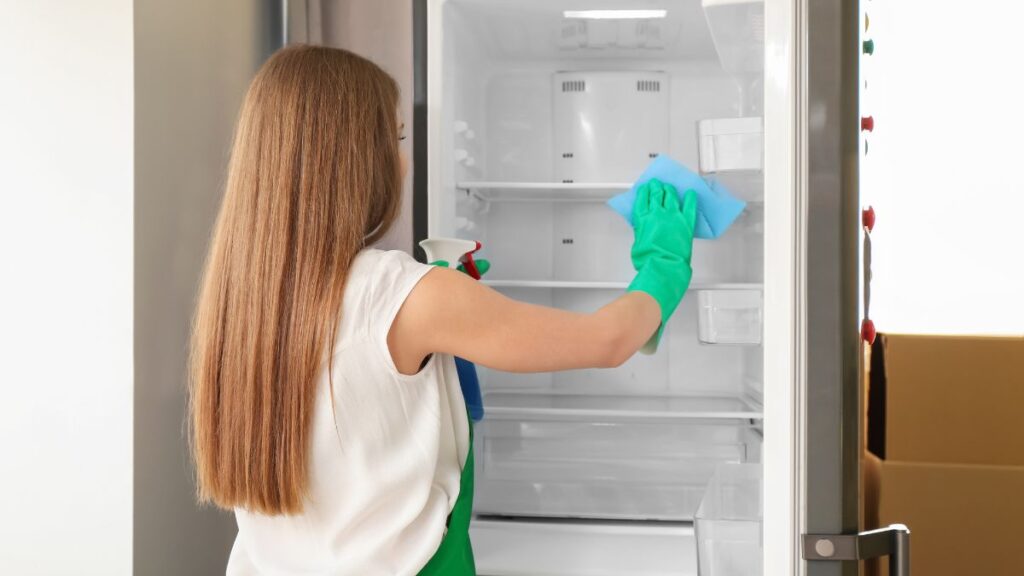
Opening your fridge on a hot day and catching a whiff of something sour reminds many why refrigerator cleaning deserves priority before summer hits.
The heat accelerates food spoilage and odor buildup fast, making neglected fridges the worst offenders in warm kitchens. Tackling the deep clean now prevents stressful messes later, giving you fresher snacks and peace of mind just as temperatures surge.

Post-Party Cleanup: Fast Track to Normalcy at Home
Party’s over? Get your home spotless fast! Follow our post-party cleanup guide to restore order and freshness in no time.
When the seasons shift, kitchens become the gathering place for cold drinks, salads, and leftovers from cookouts. This heavy use magnifies every scrape of spilled juice or forgotten produce, emphasizing the need for a strategic refrigerator cleaning routine. Think of this effort as your household’s best defense against sticky surprises and unwelcome smells as the days get longer and warmer.
This guide walks you through every step, from pre-clean prep to final details, ensuring your refrigerator cleaning is thorough, efficient, and easy enough to repeat whenever needed. Let’s get started and set your fridge up for a summer of safe, fresh storage.
Initial Prep Steps for Refrigerator Deep Sanitize
Following a clear order ensures every refrigerator cleaning session goes smoothly and safely. Start these exact steps before any scrubbing for best results.
Set aside at least an hour, and tell household members you’ll need the fridge entirely emptied for uninterrupted access. Communicate, “I’ll be cleaning the fridge thoroughly, so grab anything urgent now,” to avoid mid-clean interruptions.
Unplug and Unload: Essential Habits
Unplug the refrigerator before anything else to protect electrical components and your safety. Stack cold packs or an insulated cooler nearby, so highly perishable items like dairy and meats stay cold.
As you empty each shelf, check item dates and overall condition. Move all food to the cooler in one organized batch: condiments together, leftovers separated, produce in a bag. Take note of spoiled items and throw them out immediately.
With the fridge empty, leave the door propped open to air out lingering odors. This tiny pause helps staleness dissipate, making the next cleaning steps more pleasant and effective.
Gathering Supplies Without Overwhelm
Set out microfiber cloths, a sponge, and a soft brush for tough spots, plus a bucket for warm water and fridge-safe cleaner. Avoid abrasive pads, which can scratch plastic.
Combine two tablespoons baking soda with four cups warm water for a safe, deodorizing DIY cleaning solution. For extra power, keep white vinegar handy, which tackles sticky residue and neutralizes smells.
Keep a clean dry towel close to dry surfaces as you go, preventing water spots. This forethought speeds up reassembly and gets your refrigerator cleaning job done more efficiently.
| Step | Purpose | Best Tool | After-Clean Action |
|---|---|---|---|
| Unplug Fridge | Safety, power savings | Wall switch or plug | Keep unplugged until done |
| Empty All Shelves | Clear work zone | Cooler for perishables | Trash expired items |
| Remove Drawers | Deep access for debris | Dish soap, soft sponge | Dry before replacing |
| Wipe Down Surfaces | Clean germs, sticky messes | Baking soda solution | Dry with towel |
| Plug In & Restock | Resume normal use | Fresh food | Keep items organized |
Declutter Every Section and Create Lasting Freshness
Removing clutter is the first visible step to a cleaner fridge. Prioritize organization and freshness at each stage for long-lasting results from your refrigerator cleaning session.
As you sort, keep a separate bag for questionable foods. The phrase “Does this need to go?” is your best tool for making quick decisions and preventing future unpleasant surprises.
Making Room: Hidden Hotspots to Target
Check the very back corners and beneath crisper drawers. Old condiments, wilted herbs, or sticky jars tend to lurk here. Removing forgotten items clears space for better air circulation and cooling.
- Remove sauce bottles and wipe their bottoms—build-up attracts bugs and increases odor.
- Roll drawers forward; reach through gaps with a damp cloth for hidden fruit or spillage.
- Scoop crumbs and veggie scraps from shelf gaps with a soft brush. This step deters tiny pests, making your cleaning work last longer.
- Bag and toss old meal leftovers instead of saving “just in case”—this limits the risk of cross-contaminating fresh items later.
- After emptying, spritz shelves with DIY cleaner and let it sit while you finish other tasks. This loosens stuck-on spots for an easier final wipe-down.
Organizing as you declutter speeds up restocking and keeps refrigerator cleaning effective beyond this single deep clean. Tidy shelf arrangements help you spot issues faster the next time you open the door.
Sorting for Safety and Simplicity
Organize foods into three groups: ready-to-eat, cook-before-eating, and condiments. Place the soonest-to-expire items toward the front, labeling lids if needed with a marker for easier tracking.
- Group all deli meats together, avoiding direct contact with cheeses to minimize odor transfer. Place them on the middle shelf for stable cooling.
- Arrange produce by type, keeping leafy greens and ethylene-producing fruits in separate drawers. This slows wilting and prevents flavors from blending undesirably.
- Divide sauces by frequency of use, putting family staples at the door for easy grab-and-go access after restocking.
- Label any open jars or leftovers with today’s date, making it obvious when to toss or use before next week’s deep clean.
- Seal dry goods—like open flour or grains—in air-tight containers to minimize the mess should bags rip or spill during regular usage.
Take a moment to enjoy the neat look—this approach transforms refrigerator cleaning into a manageable routine that saves time and prevents food waste.
Handle Drawers, Doors, and Gaskets With Precision
Cleaning removable parts thoroughly reduces future odor risk and keeps important seals working. This focused refrigerator cleaning strategy catches details you may usually overlook.
Remove all drawers and bring them to the sink for deeper soaking. Gently pull shelf liners if present, tossing old ones and setting replacements aside to dry completely before reassembling shelves and bins.
Deep Cleaning Vegetable Drawers
Fill your kitchen sink with warm water, adding a tablespoon of mild dish soap. Submerge each drawer fully, agitating with your hands to loosen sediment and sticky spots around edges and seams.
Target stubborn stains with a toothbrush, scrubbing gently along corners but avoiding harsh pressure that might scratch the plastic. Rinse under running water until suds disappear and pat dry with a towel.
Let drawers air dry upside down on a rack so moisture can escape. This prevents plant-based residues from fermenting and ensures they’re truly bacteria-free before reuse.
Door Seals: The Mold and Odor Trap
Dampen a cloth lightly with vinegar. Gently pinch rubber gaskets open and sweep your cloth along the inner and outer edges, inspecting for buildup and hidden crumbs or debris.
Persist with another pass of the cloth if you notice grime—a double-wipe approach helps fully sanitize squeezable areas. If visible mold is present, use a cotton swab dipped in vinegar for tight grooves.
After cleaning, dry gaskets with a new towel, stretching them open just enough to let air in. Strong seals keep cold air locked in, saving energy and blocking odors between refrigerator cleaning routines.
Sanitizing Surfaces for Germ-Free Results
Every completed swipe in this stage cuts down on unseen bacteria and keeps food safe. Diligent refrigerator cleaning techniques should leave every surface sparkling, not streaky.
Spray all interior walls, trays, and shelf edges with your preferred cleaner or diluted white vinegar. Leave the solution to soak for three to five minutes, allowing active ingredients to break down grease and stains.
Polish Stainless Finishes Without Streaks
For homes with stainless steel refrigerator doors, spritz a microfiber towel with vinegar or an appliance spray, never applying directly to the surface to prevent overspray and spotting.
Wipe in the direction of the steel’s grain. Consistent, even passes prevent cloudiness and keep your appliance shining after refrigerator cleaning, even in bright summer sunlight.
Buff with a second dry cloth to eliminate water marks. This fast detail separates a so-so fridge from a guest-ready kitchen centerpiece, especially with increased holiday visitors.
Use Safe Food Contact Cleaners
Always double-check cleaner labels and avoid bleach or ammonia-based formulas for interior surfaces that touch food. Food-safe sprays or a baking soda solution are ideal choices, offering sanitization without lingering chemicals.
If your refrigerator cleaning session includes commercial wipes, confirm “food contact safe” status and do a final rinse with water after use. Leave the door open for ten minutes to air out all traces of cleaner before restocking.
Remember: surfaces that feel slick or sticky often still have traces of cleaner or food. Run a clean, wet cloth over these spots again until you feel only slick plastic or glass under your fingertips.
Combat Odors and Keep Freshness Long After the Clean
Securing a lasting fresh scent is a winning move after refrigerator cleaning. Odor control prevents waste and maintains a pleasant kitchen environment through every hot day.
Add a dedicated deodorizer, such as an open box of baking soda, to the back corner of your fridge, replacing it every three months as part of your seasonal maintenance. Alternatively, use activated charcoal packets for extended odor absorption.
Absorb Odors at the Source
Slide coffee grounds or charcoal into an open container with holes in the lid, keeping these near the worst hotspots found during your refrigerator cleaning step. This neutralizes strong cheese or fish odors until your next deep clean.
Replace all absorbents promptly after heavy use or when smells linger, ensuring there’s always a fresh one in place as the weather gets warmer. This routine keeps your kitchen air inviting.
If you notice unwanted smells even after cleaning, track down spills or spoiled produce immediately. Never mask bad odors without locating the cause, as ignoring underlying issues undoes even the most thorough refrigerator cleaning jobs.
Restocking and Building a Clean-Living Routine
Restocking your sanitized fridge with intentional order saves time and supports long-term refrigerator cleaning success. Arrange foods by frequency of use and expiration date for a neat, functional setup.
Test this script: “Anything with last week’s label goes in front; newest groceries fill the back.” This habit flows smoothly into everyday routines, encouraging consistent freshness checks without extra effort at each mealtime.
Refrigerator Cleaning Weekly Micro-Checklist
- Wipe shelf corners with a damp towel; this removes crumbs before they become sticky and hard to clean later in the season.
- Toss leftovers more than four days old to prevent unpleasant smells from forming and to keep space clear for new, safer meals.
- Inspect gaskets for trapped food particles. Clean these during weekly wipe-downs to prolong seal life and block incoming odors.
- Check expiration dates on dairy and condiments. Consolidate if duplicates exist, reducing crowding and streamlining the next refrigerator cleaning routine.
- Rotate beverages and snacks so that high-traffic items are within easy reach, which minimizes spills and keeps the fridge neat on busy days.
Make these small steps a regular family habit for year-round cleanliness and less stress when preparing snacks or meals during summer gatherings.
Smart Maintenance Tips for Long-Term Results
Sustained refrigerator cleaning pays off most with minor habits you add to your daily or weekly schedule. Each quick check reduces surprises and costly repairs.
Keep an eye on temperature dials and sensors after deep cleans, as these can reset when the fridge is unplugged or heavy shelves get jostled. Confirm correct settings for safety and efficiency.
Exterior and Vent Cleaning for Efficiency
Wipe fridge sides and exposed top panels while restocking. Dust and grease on exterior surfaces insulate and strain the compressor, especially in summer heat—so keep these consistently clean.
Once a month, use a vacuum with a hose attachment to gently clean vents, grills, or coils at the back and underneath. This allows for proper air exchange, supporting consistent cooling even during heatwaves.
If pets are in your household, inspect these areas more frequently. Animal hair and dust buildup can speed compressor wear, undoing the benefits of careful refrigerator cleaning inside and out.
Digital Reminders to Stay Consistent
Set recurring calendar alerts for quarterly deep refrigerator cleaning routines and monthly mini-checks. Linking these with trash day or a regular grocery run increases follow-through for every household member.
Share reminders with “Mark fridge for cleaning this Saturday” grouped in your home chat list or posted on the fridge itself for an effective prompt. This normalizes maintenance and supports household participation.
Reward kids for helping out—offer a small treat or allow them to choose a new fridge magnet once the job’s done, promoting positive associations with cleanliness and collective responsibility.
Frequently Asked Questions
Most home experts recommend a full deep-clean every three to four months, with mini cleanups after spills or before and after vacations. Routine cleaning prevents odor buildup and keeps food safer for everyone in the household.
Bleach isn’t recommended for fridge interiors, as strong fumes linger and may contaminate food. Opt for mild dish soap, baking soda, or food-safe commercial cleaners to sanitize without risk and keep surfaces residue-free after a deep refrigerator cleaning.
Onions, strong cheeses, and fish typically create the toughest odors, especially if stored unwrapped or in loose containers. Always double-wrap and place in airtight bins, or use odor-neutralizing products in targeted refrigerator cleaning steps for lasting freshness.
If you have only 20 minutes, focus on the highest-risk areas—wipe the door handle, gaskets, shelf surfaces, and toss obvious expired foods. Schedule a complete refrigerator cleaning soon to ensure longer-lasting results and kitchen safety.
Sticky spills should be cleaned immediately with a damp towel and mild cleaning solution. Placing a fridge liner under bottles and regularly checking for leaks limits buildup, supporting a cleaner and more manageable refrigerator cleaning process all summer.

Autumn Leaf and Gutter Cleaning Made Simple
Prepare your home with our autumn leaf and gutter cleaning guide. Learn time-saving routines, gear tips, and leaf removal tricks for safer, cleaner fall living. Stop wate


